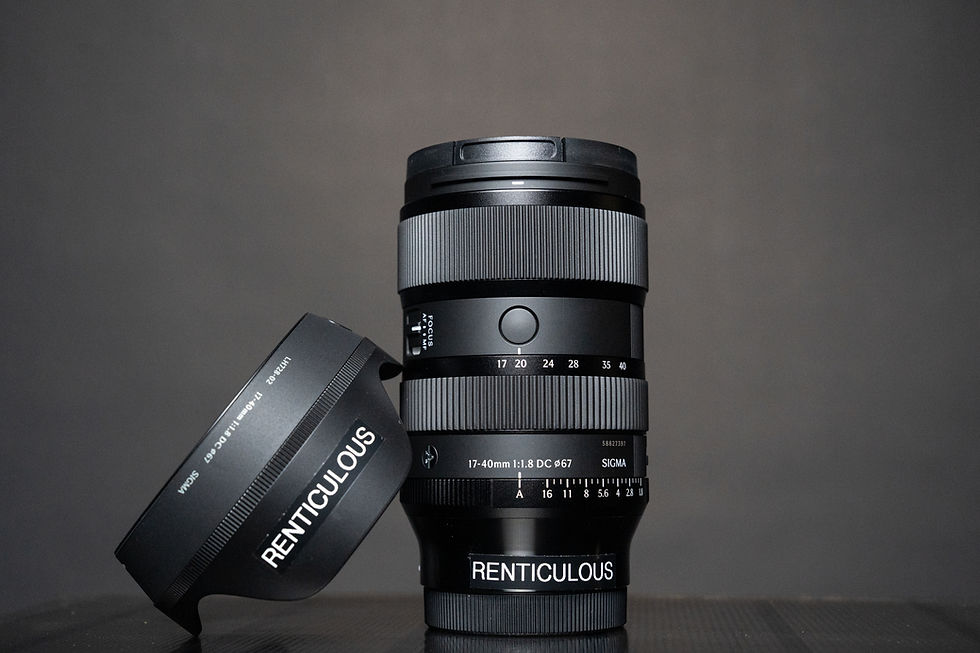All About Prime Lenses
- renticuloussg
- Jul 11, 2023
- 4 min read
We hope you are as happy as we are because we can finally start traveling again! Renticulous thanks each and every one of you for your support, and we will continue to humbly serve you with our best equipment.
Today, we are back with lenses, specifically prime lenses! For beginners who are still learning about the different types of lenses, please check out our general lens blog here! Prime Lens, Sony, Canon, Tamron, Sigma, Samyang All About Lenses

Prime lenses, also known as fixed focal length lenses, are camera lenses with a single, fixed focal length. Unlike zoom lenses that offer a variable focal length range, prime lenses provide a fixed field of view and cannot zoom in or out.
Now, you might be wondering why you would need a prime lens when you can have a zoom lens with a more flexible focal length.
Reasons why we value Prime lenses:
Image Quality: Prime lenses often provide superior image quality compared to zoom lenses due to their simpler optical design. They typically have fewer lens elements, which can result in sharper images, reduced chromatic aberration, and less distortion.
Wide Aperture: Many prime lenses have wide maximum apertures, represented by smaller f-numbers (e.g., f/1.8, f/1.4). The wide aperture allows more light to enter the lens, enabling faster shutter speeds and better performance in low-light conditions. It also enables photographers to achieve a shallow depth of field, separating the subject from the background and creating a pleasing bokeh effect.
Compact and Lightweight: Prime lenses tend to be smaller, lighter, and more portable than zoom lenses. This makes them convenient for travel or situations where minimising the gear's size and weight is important.
Specialised Use: Some prime lenses are specifically designed for certain types of photography, such as macro lenses for close-up photography, wide-angle lenses for landscapes, or telephoto lenses for sports and wildlife photography. These lenses offer optimised performance for their respective purposes.

Example of photos taken with Prime lenses:
Here are some of the photos our crew took for our Instagram feed!



If you wish to achieve a blurry and creamy bokeh background effect like this, we usually recommend using a prime lens for its wider aperture. One thing to note is that prime lenses do not have a zoom function, which means that the focal length will always remain the same. So, if you find yourself in a tight spot or if you feel the lens is too wide for a closer shot, you might have to physically move around instead of zooming in and out like on your iPhone!
Our recommendations:
We know that there are a lot of types of prime lenses in the market, making it challenging to choose. Here are some of our recommendations for you:
35mm lens:
A 35mm prime lens offers a versatile focal length that is suitable for various types of photography, including street, documentary, and general travel shots. It provides a natural perspective and allows you to capture wide-angle scenes while still being able to isolate subjects with a shallow depth of field.
Some example of the 35mm would be:
Sony FE 35mm f/1.4 GM Lens
Sony FE 35mm f1.8 Lens
Sigma 35mm f/1.4 DG HSM Art Lens
Canon EF 35mm f/1.4L II USM Lens
Canon RF 35mm f/1.8 IS Macro STM
50mm lens:
A 50mm prime lens, also known as a "standard" lens, is a classic choice for travel photography. It closely mimics the perspective of the human eye, making it great for capturing everyday scenes and portraits. The wide aperture of either f/1.8, f/1.4 or even f/1.2 allows for excellent low-light performance and beautiful background separation.
Some example of the 50mm would be:
Sony FE 50mm f/1.2 GM Lens
Sony FE 50mm f/2.5 G Lens
Sony Sonnar T* FE 55mm f/1.8 ZA
Canon RF 50mm F1.2 L USM
Canon RF 50mm f/1.8 STM Lens
24mm lens:
A 24mm prime lens provides a wider field of view, making it ideal for landscape photography and capturing expansive cityscapes. It allows you to include more of the surroundings in your frame, while still maintaining a natural perspective. A wide aperture of f/2.8 or wider enhances low-light capabilities and offers creative depth of field control.
Some example of the 24mm would be:
Sony FE 24mm f/2.8 G Lens
Sony FE 24mm f/1.4 GM Lens
Sigma 24mm f/1.4 DG HSM Art Lens
Canon RF 24mm f/1.8 Macro IS STM
85mm lens:
If you enjoy capturing portraits or details during your travels, an 85mm prime lens can be a valuable addition to your gear. It offers a short telephoto focal length, allowing you to isolate subjects and achieve a pleasing background blur. The wide maximum aperture of f/1.8 or f/1.4 produces excellent subject separation and performs well in low-light conditions.
Some example of the 85mm would be:
Sony 85mm F1.8 Lens
Sony FE 85mm f/1.4 GM Lens
Sigma 85mm f/1.4 DG DN Art Lens
Canon RF 85mm f/1.2 L USM Lens
Canon RF 85mm f/2 Macro IS STM Lens
Final thoughts
Prime lenses can be a bit challenging to use initially, especially if you're accustomed to the convenience of a zoom function on your phone. However, most experienced photographers and videographers tend to prefer prime lenses over zoom lenses due to their superior image quality and wide aperture capabilities.
With the multitude of prime lens options available on the market, you are indeed spoiled for choice. Each lens offers unique characteristics and advantages, allowing you to find the perfect fit for your shooting style and preferences.
If you have any concerns or questions regarding lens choices, don't hesitate to reach out to us. Our knowledgeable staff will provide you with the best possible options based on your requirements.
Psst! As an additional incentive, we have some promotions running for the month of July. Head over here to discover more about the exciting offers we have in store for you!



